I’ve got a gem of a recipe to share with you – my all-time favorite Dutch Oven Sourdough Bread.
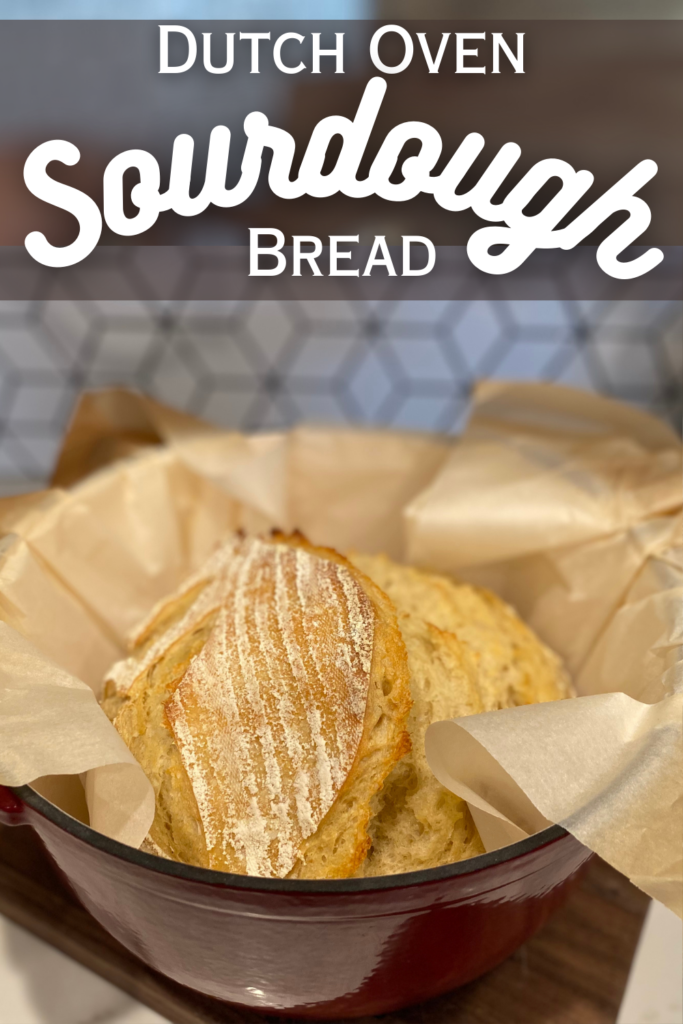
Dutch Oven Sourdough Bread
Seriously, this one’s a game-changer! Craft your own artisan-style sourdough that’s irresistibly light, fluffy, and boasts that iconic crunchy crust. It’s the stuff dreams are made of, I promise!
I’m diving into this simple four-ingredient wonder that’ll make you question why you ever bothered with store-bought bread! Say goodbye to commercial yeast – we’re letting our trusty active starter (or mother dough) work its magic.

Ingredients
This Dutch oven sourdough bread recipe is one of my favorite sourdough recipes, and is super simple to make!
Only four simple ingredients work together like magic and transform into the most beautiful, light, and fluffy artisan sourdough bread! Its crunchy crust and chewy insides impress the toughest critics, and satisfy the soul!
- 2 cups 100% hydration active starter This takes the place of commercial yeast in common bread.
- 3 cups sifted of all-purpose flour (You can also use whole all purpose grain flour)
- 1+1/4 cup warm water (cold water will make dough take longer to rise.)
- 1.5 teaspoons salt
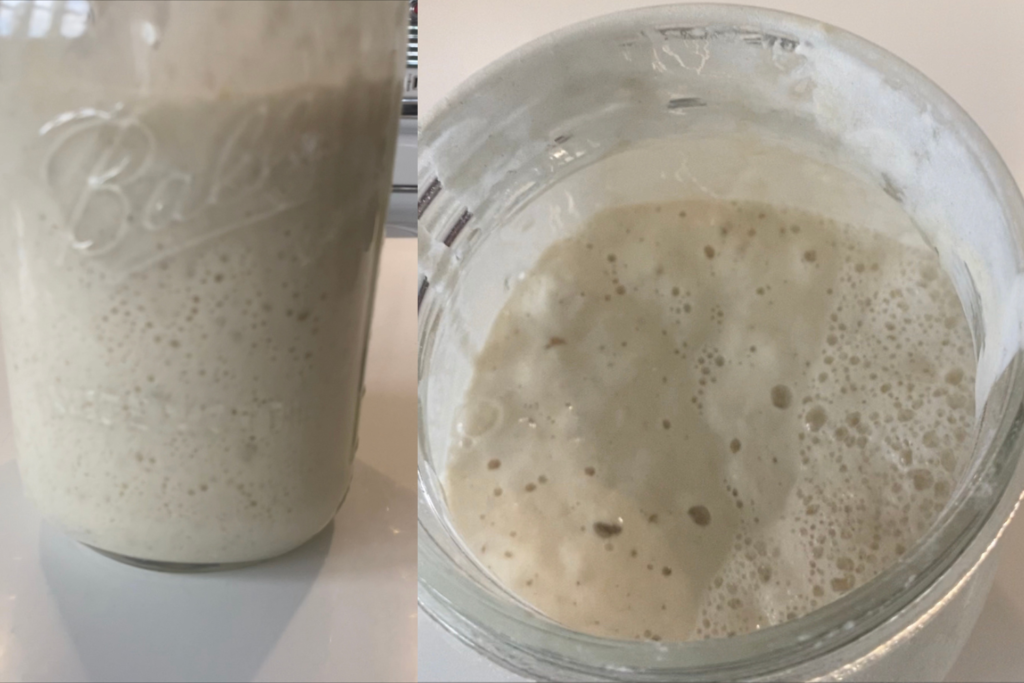
Instructions
In a large mixing bowl (not metal) add 2 cups of 100% hydration active sourdough starter. (Meaning sourdough starter made equal parts water and flour:)
(For active sourdough starter, feed it and keep it out of the fridge for at least 4 hours, or overnight.)
Add 3 cups of sifted flour.
(Sift or fluff your flour before measuring so it isn’t too compact in the measuring cup.)
Add 1 and 1/4th cup of warm water
Add 1.5 teaspoons salt. (I use the Himalayan Pink Salt, use your favorite!)
Use a large wooden spoon to mix the ingredients together. It will be wet, biscuit-like dough. (I do not use a dough whisk or hook in this recipe, the stretch and fold method develops the gluten instead!)
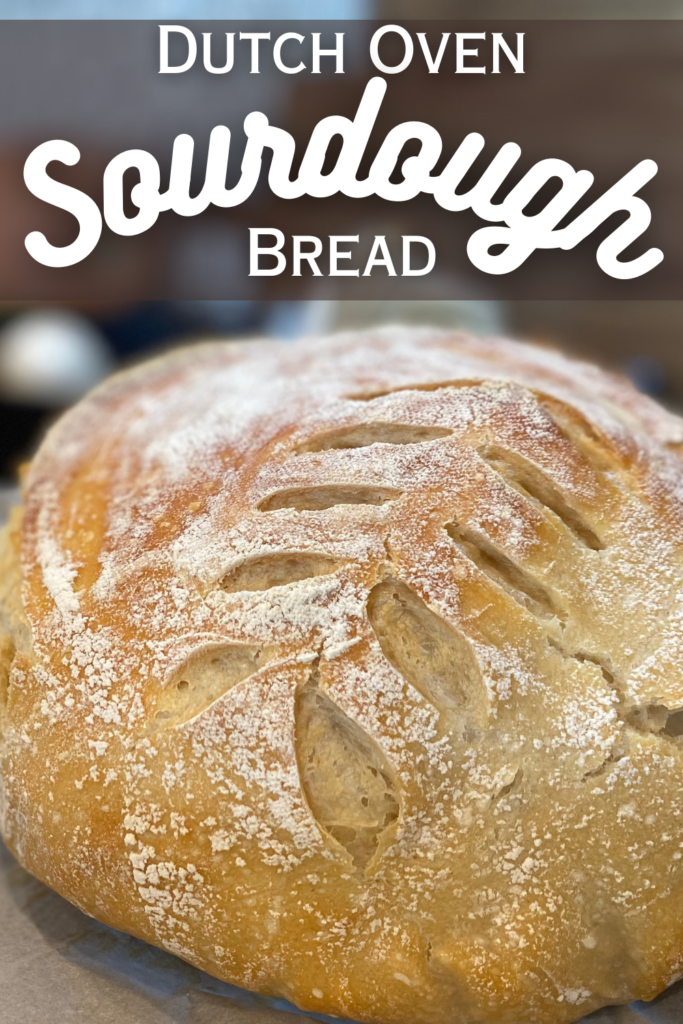
Stretch & Fold Sourdough Bread Method
- Cover with a clean damp kitchen towel, and let the dough rest in a room temperature warm place for 2 hours. (Or in a warm oven for about 1 hour)
- First time stretch and fold: Uncover the dough, with wet hands pick up one side of the dough and fold it in half, over on top of the other side of the dough. Repeat 4 times by stretching and folding over all four sides of the dough. (The dough does not stick to wet hands as badly as dry hands.)
- Cover with a clean towel (or plastic wrap), and let the dough rise till doubled again.
- Second time stretch & fold: Uncover the dough, wet your hands, then pick up one side of the dough and fold it in half, over on top of the other side of the dough. Repeat 4 times by stretching and folding over all four sides of the dough. The dough is becoming more bread-like now!
- Cover with a clean towel, and let rise till doubled again.
- Next step, is the 3rd stretch and fold: Uncover the dough, wet your hands, then pick up one side of the dough and fold it in half, over on top of the other side of the dough. Repeat 4 times by stretching and folding over all four sides of the dough. The dough is even more bread-like now!
- Cover with a clean towel, and let rise till doubled again.
- 4th stretch and fold: Uncover the dough, wet your hands, then pick up one side of the dough and fold it in half, over on top of the other side of the dough. Repeat 4 times by stretching and folding over all four sides of the dough. The dough is even more bread-like now!
Shape your dough into a round sourdough loaf.
- Dust a towel, or proofing basket, generously with flour and put it into a large round bowl to rise one last time.
- Turn bread dough out onto a lightly floured work surface,
- Final Shape- Shape dough into a round loaf by pushing it back and forth to build surface tension on your loaf.
- Using a bench scraper, Place the dough ball into the floured towel in the large bowl, or into a floured banneton basket.
- Dust the top of dough ball generously with flour.
- Cover with a towel by folding over the ends (or use another clean towel.)
- For a chewy texture, many prefer letting the dough rise overnight. Place the bowl into the refrigerator to chill and rise overnight, as bulk fermentation and final rise. (Now you can rest and pick up where you left of the next day!)

Day 2 – Baking Sourdough Bread
- The next morning, when you are ready to bake, preheat your oven to 400 degrees F. and place your best Dutch oven into the oven to preheat too.
- Cut a 2-foot section of parchment and place it on your counter.
- Gently dump your chilled bread dough ball onto a large piece of parchment paper.
- Lightly dust the top with flour, and spread it evenly over top with your hand, being careful not to push the dough down.
Using a very sharp knife or razor blade, score a design into the top of the loaf dough.
- Score the top of your dough with your razor blade. Make your own design or use mine. This gives the loaf a constructive place to rise without bursting open during the baking process.
- Remove your hot dutch oven from your preheated hot oven.
- Lift your dough loaf into the preheated dutch oven by the ends of the parchment paper. (It’s ok for parchment paper to hang over the sides of the dutch oven, it won’t burn.)
- Place the lid on your dutch oven.
- Use hot pads or towels to put the hot dutch oven back into the preheated oven at 400 degrees.
- Bake covered for 25 minutes.
- Then, Remove the dutch oven lid to create that crispy crust.
- Bake for 25 more minutes! Your loaf should be nice and golden brown on top by now!
- Remove and place on a safe surface. (I like to use a cutting board or my stove top.)
- Place your sourdough bread on a cooling rack and cool completely to see all the beautiful air holes! If you cut into your loaf of bread right away the bread will be too soft to hold its form with all the beautiful air holes. It will taste amazing but doesn’t look quite as wonderful. Enjoy!
Dutch Oven Sourdough Recipe Variations
I have made this homemade sourdough bread recipe with whole wheat flour several times and it turned out wonderful… A bit more dense, but that’s what you want with 100% whole wheat.
Sourdough Recipes
Easy Pancakes – Sourdough Starter Pancakes
Recipe Card
If you try this recipe, I’d love if you give it a review on the recipe card, and let me know how it turned out in the comments or review! Tag me on Instagram @farmhouse_harvest with your delicious creation!
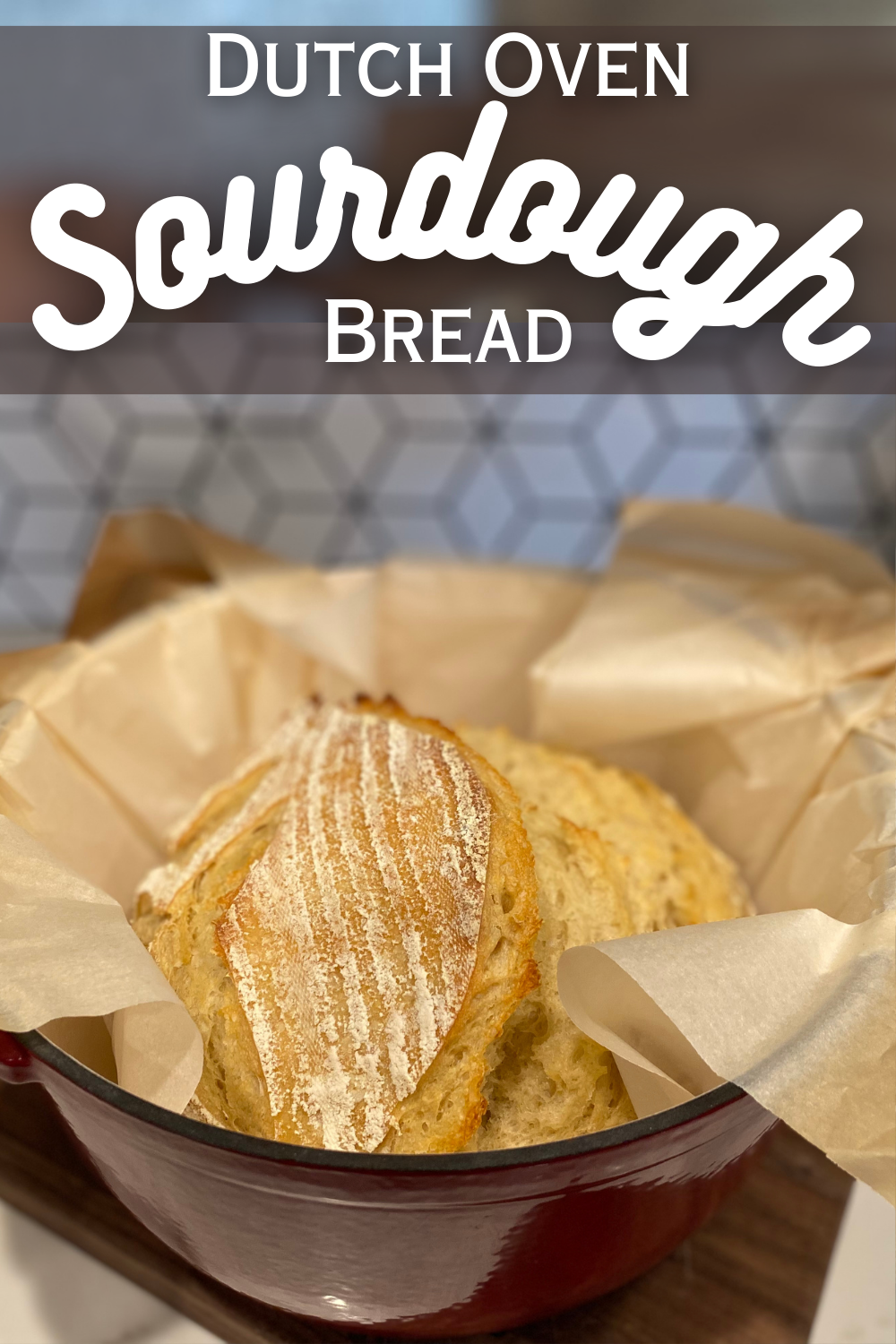
Dutch Oven Sourdough Bread Recipe
Ingredients
- 2 cups 100% hydration active starter This takes the place of commercial yeast in common bread.
- 3 cups sifted of all-purpose flour You can also use whole all purpose grain flour
- 1 +1/4 cup warm water cold water will make dough take longer to rise.
- 1.5 teaspoons salt
Instructions
- In a large mixing bowl (not metal) add 2 cups of 100% hydration active sourdough starter. (Meaning sourdough starter made equal parts water and flour:)
- (For active sourdough starter, feed it and keep it out of the fridge for at least 4 hours, or overnight.)
- Add 3 cups of sifted flour.
- (Sift or fluff your flour before measuring so it isn't too compact in the measuring cup.)
- Add 1 and 1/4th cup of warm water
- Add 1.5 teaspoons salt. (I use the Himalayan Pink Salt, use your favorite!)
- Use a large wooden spoon to mix the ingredients together. It will be wet, biscuit-like dough. (I do not use a dough whisk or hook in this recipe, the stretch and fold method develops the gluten instead!)
Stretch & Fold Sourdough Bread Method
- Cover with a clean damp kitchen towel, and let the dough rest in a room temperature warm place for 2 hours. (Or in a warm oven for about 1 hour)
- First time stretch and fold: Uncover the dough, with wet hands pick up one side of the dough and fold it in half, over on top of the other side of the dough. Repeat 4 times by stretching and folding over all four sides of the dough. (The dough does not stick to wet hands as badly as dry hands.)
- Cover with a clean towel (or plastic wrap), and let the dough rise till doubled again.
- Second time stretch & fold: Uncover the dough, wet your hands, then pick up one side of the dough and fold it in half, over on top of the other side of the dough. Repeat 4 times by stretching and folding over all four sides of the dough. The dough is becoming more bread-like now!
- Cover with a clean towel, and let rise till doubled again.
- Next step, is the 3rd stretch and fold: Uncover the dough, wet your hands, then pick up one side of the dough and fold it in half, over on top of the other side of the dough. Repeat 4 times by stretching and folding over all four sides of the dough. The dough is even more bread-like now!
- Cover with a clean towel, and let rise till doubled again.
- 4th stretch and fold: Uncover the dough, wet your hands, then pick up one side of the dough and fold it in half, over on top of the other side of the dough. Repeat 4 times by stretching and folding over all four sides of the dough. The dough is even more bread-like now!
- Shape your dough into a round sourdough loaf.
- Dust a towel, or proofing basket, generously with flour and put it into a large round bowl to rise one last time.
- Turn bread dough out onto a lightly floured work surface,
- Final Shape- Shape dough into a round loaf by pushing it back and forth to build surface tension on your loaf.
- Using a bench scraper, Place the dough ball into the floured towel in the large bowl, or into a floured banneton basket.
- Dust the top of dough ball generously with flour.
- Cover with a towel by folding over the ends (or use another clean towel.)
- For best results and that chewy texture we all love, Place the bowl into the refrigerator to chill and rise overnight, as bulk fermentation and final rise. (Now you can rest and pick up where you left of the next day!)
Day 2 – Baking Sourdough Bread
- The next morning, when you are ready to bake, preheat your oven to 400 degrees F. and place your best Dutch oven into the oven to preheat too.
- Cut a 2-foot section of parchment and place it on your counter.
- Gently dump your chilled bread dough ball onto a large piece of parchment paper.
- Lightly dust the top with flour, and spread it evenly over top with your hand, being careful not to push the dough down.
- Using a very sharp knife or razor blade, score a design into the top of the loaf dough.
- Score the top of your dough with your razor blade. Make your own design or use mine. This gives the loaf a constructive place to rise without bursting open during the baking process.
- Remove your hot dutch oven from your preheated hot oven.
- Lift your dough loaf into the preheated dutch oven by the ends of the parchment paper. (It's ok for parchment paper to hang over the sides of the dutch oven, it won't burn.)
- Place the lid on your dutch oven.
- Use hot pads or towels to put the hot dutch oven back into the preheated oven at 400 degrees.
- Bake covered for 25 minutes.
- Then, Remove the dutch oven lid to create that crispy crust.
- Bake for 25 more minutes! Your loaf should be nice and golden brown on top by now!
- Remove and place on a safe surface. (I like to use a cutting board or my stove top.)
- Place your sourdough bread on a cooling rack and cool completely to see all the beautiful air holes! If you cut into your loaf of bread right away the bread will be too soft to hold its form with all the beautiful air holes. It will taste amazing but doesn't look quite as wonderful. Enjoy!
Nutrition
Let me know what you think!
Share your cooking tips and feedback in the comments below. Did you add any twists to these recipes? I’d love to hear!
Sourdough Starter Hydration
When we talk about hydration in the context of sourdough, we’re diving into the delicate balance between water and flour within your starter. Think of it as a harmonious relationship where each ingredient brings its own unique character to the mix.
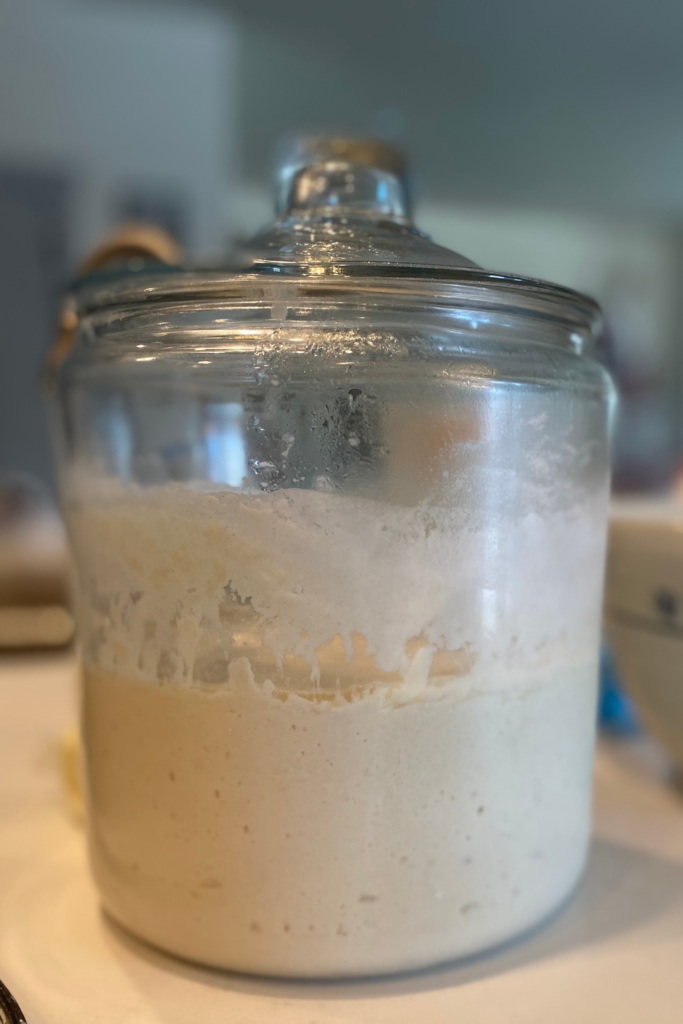
Imagine this: your sourdough starter is like a living ecosystem of wild yeast and friendly bacteria. These microorganisms work their magic on the flour-water duo, creating a fermentation symphony that gives rise to your delicious bread. And hydration? It’s the conductor, orchestrating the entire process.
Now, let’s clear up a common terminology point. When you mention that your sourdough starter is “half flour and half water,” you’re referring to a 100% hydration starter. In this scenario, the weight of the water in your starter is equal to the weight of the flour. It’s a 1:1 ratio, creating a dough-like consistency that’s both manageable and conducive to fermentation.
Why does this matter? Well, hydration level impacts everything – from the dough’s initial mixing to its final texture, crumb structure, and even flavor. A higher hydration starter, say 120%, would be more liquid-like, resulting in an open crumb and a chewy interior. On the other hand, a lower hydration, around 60%, would give you a denser, more traditional loaf.
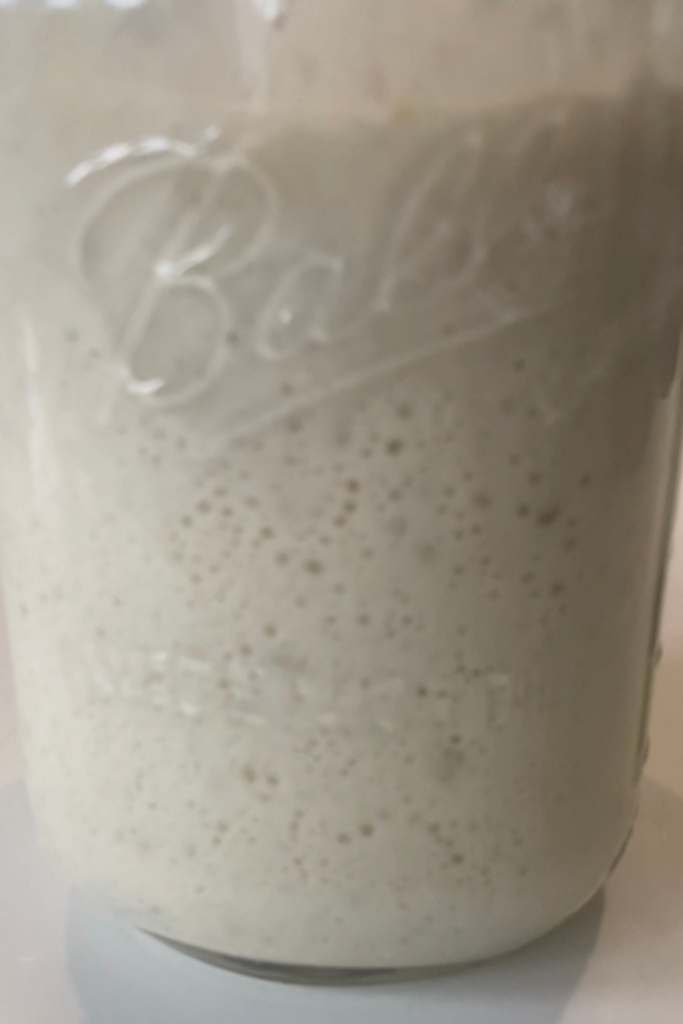
The Right Balance
Your 100% hydration sourdough starter strikes a beautiful middle ground. It provides enough moisture to facilitate fermentation and flavor development, yet it’s not overly wet, making it easier to handle and shape.
This balance is essential because it dictates the pace at which fermentation occurs. The higher the hydration, the more active the fermentation, which leads to that characteristic sourdough tang and those lovely air pockets we adore.
Remember that hydration is your ally… It’s like the chef’s secret seasoning – the element that elevates your bread from basic to extraordinary. As you nurture your starter and watch it transform flour and water into something incredible, you’ll truly appreciate the magic of hydration in sourdough baking. Happy baking, and may your loaves always rise to perfection!
Sources

About Juliea
Juliea Huffaker is the creator of Farmhouse Harvest, and dedicated to teaching from-scratch cooking, sourdough baking, gardening, and food preservation. With over 25 years of hands-on experience she has preserved hundreds of jars of produce, mastered the art of meats and sourdough baking, and nurtured a thriving organic garden. Her recipes and articles have been featured across the web. And she’s passionate about inspiring others to embrace a simpler, self-sufficient life style.









2 comments
Juliea Huffaker
Hi Jolene! It may be over fermenting… I always bake my bread early the next day. Because it has cups of starter in it, it ferments faster than most sourdough recipes… Which is why you can bake in one day one. It only needs to be refrigerated for about 4 hours till it can be baked. So if you leave it in the fridge for too long it will over ferment and not rise like it should. I refrigerate mine from 4-10 hours. 24 hours is too long. Also, make sure you flour your towel or banneton basket liner really well so it doesn’t stick.
Juliea Huffaker
Hello Frank! Thank you so much for trying my recipe… Yes, you stretch and fold around your dough bowl on each side, so 4 stretch and folds…. Then let it rise a gain, and stretch and fold on all 4 sides of your dough, then let it rise again and then stretch and fold on all four sides of the dough bowl… So you let it rise and do stretch and folds 4X’s. So yes a total of at least 16 stretch and folds… You can also do more, but not less. Thank you for your question!